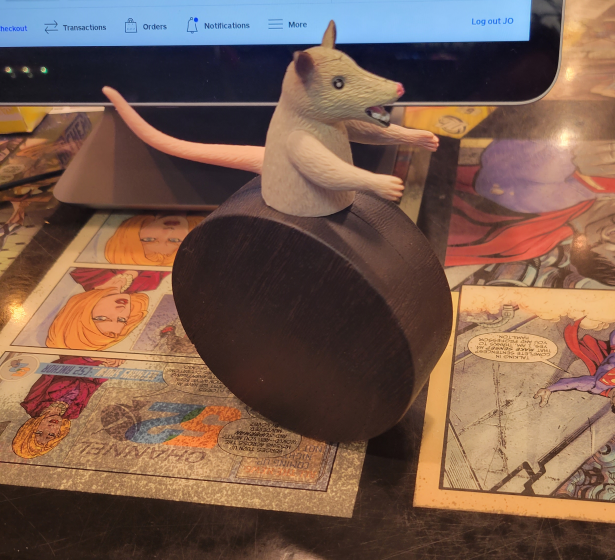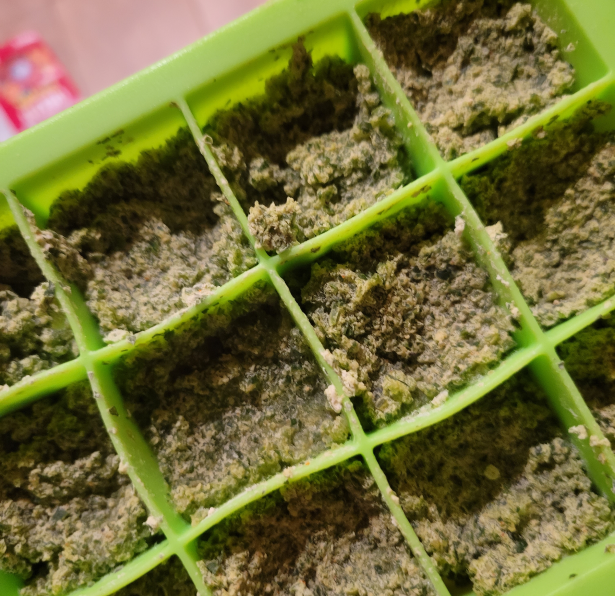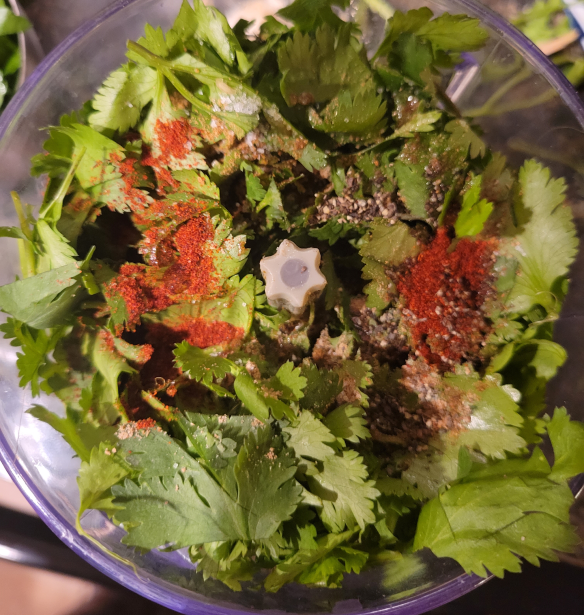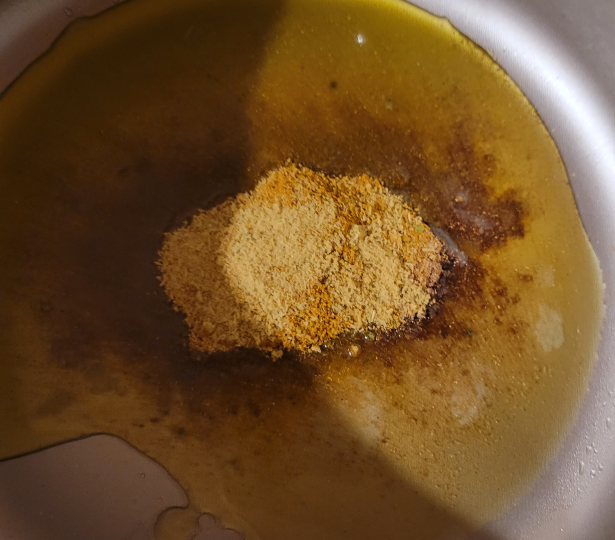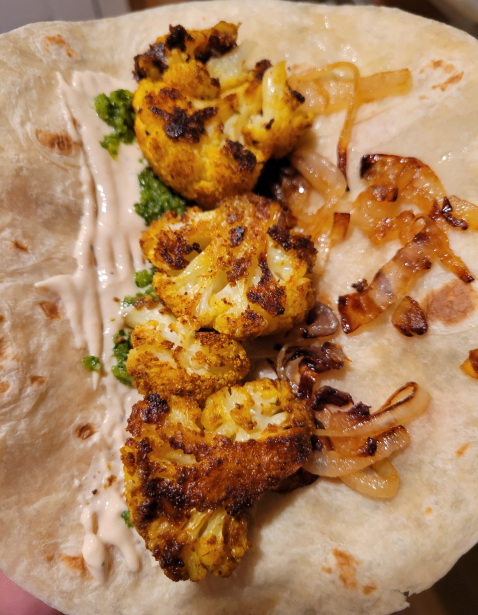KC 317 – Cauliflower Shawarma Tacos

Why hello there, and welcome back to Kitchen Catastrophe, where we’re certainly doing something with that title, eh? Oh yeah, we’re going on a culinary journey with this one. Probably not as far as you’re thinking, though. The recipe is one of those “complicated only because it represents several simple things all brought together” kind of recipes, so we’re going to make 2 sub-recipes to handle this sucker. If you want to jump straight to cooking, this link will take you where you need to go. For everyone else, let’s dig in.
A Muddled Mess of Culinary Quirks
That Title might be a little aggressive. BUT, today’s recipe is…rather interesting, And it comes from a very interesting place. Firstly, I do want to note that this is not technically shawarma…maybe. Shawarma is, and I think we’ve talked about this before, but just to cover my bases, basically just Middle Eastern gyros. To be more specific and NOT dash any hopes of one day getting to see Istanbul: the dish of döner kebab, meat cooked on a vertical spit, shaved off into pita sandwiches, was invented in Turkey, where the name basically means “rotisserie kebab”: Döner is a derivative of “dönmek”, or “rotating”. The dish was thus translated into Greek as “gyro” (“turning”), a calque of the Turkish (Calques are, and I KNOW we’ve talked about this before, when you take a foreign word for a new concept using older words, and translate those words. Like, the tool you click to use a computer is a “mouse” and thus is it ALSO called “un ratón” (a mouse) in Spanish. Compare to “Ice Cream”, which Spanish called “helado”, not “crema con hielo”) and into Arabic as shawarma, based on the Turkish word çevirme, meaning “turning”. So both Greek and Arabic copied the wrong word for their translations of Turkish dishes.
Man, I could go for some of that “spin meat”.
“I thought it was rotate roast”.
“Whatever.”
Now, this means, technically, that if you don’t cook the food on a rotating vertical spit, you’re not making it correctly, and it’s not döner/gyros/shawarma. But most view this as a little ungenerous: arguing that the spices are the defining characteristic, since it’s unreasonable to expect people to have vertical spits in their homes. Or at least, the idea of “homemade” Shawarma is a different beast from ‘real’/’restaurant’ shawarma. I I don’t THINK there’s a particularly heated or emotionally charged debate to this, it’s more an academic squabble: people in the relevant nations know when they’re making “real” ones, versus knock-offs at home, and use the name that’s easier, and don’t care if people in other countries typically only get to make the knock-offs. Like how relatively few Indian households in America have tandoor ovens, but they still make “tandoori chicken”.
Anywho, This particular recipe is particularly interesting, because it carries some quirks from the author I picked it up from, and because it lets me introduce you to a foodstuff that’s been nibbling on the edges of my sanity for a while. But before we hunt the rats in the walls, let’s talk about that chef: Molly Yeh. Molly is one of the “newer” Food Network stars (I put newer in quotes because, for the last couple years, I haven’t gotten to watch much Food Network, due to my mother’s new work schedule and my growing inability to manage my YouTube consumption. (I hit THIRTY goddamn tabs the other day. I used to consider 20 a sign that I was going overboard. I have tabs that have been open for 11 MONTHS.) So it’s entirely possible that Molly is comparatively established versus other stars, but as far as I’m aware, she’s still only got like, one show*, and her second cookbook hasn’t come out yet**, so I think of her as new.) Molly is a American...chef? of Chinese and Jewish descent. And I do not put that question mark there as a sign of disrespect, but rather to highlight that Molly is actually like, a more successful, younger, presumably happier version of me: she’s a Julliard graduate who started a food blog in New York, got married, made a cookbook, and then got on the Food Network. She isn’t professionally trained in cooking, so she’s not technically a chef, a point I am sure I am by no means the first person to bring up, since Wikipedia notes that her older sister IS a chef, so I bet that particular detail has come up a few times.
As an older brother, I know exactly the kind of arguing and fuss that precedes nice pictures like this.
(* - technically, her one show has gone for...”ten seasons” in that “two seasons per year, a season is 7 to 13 episodes” style, and she’s actually started hosting another one. ** - Turns out that what I thought was her second cookbook was her THIRD, as she put out a 48 page recipe book on Yogurt in 2018)
Molly’s food is a fascinating and great mix of influences: her family, as noted, is Chinese and Jewish. Molly spent a fair amount of time in Israel, and bases at least the spice mix for the cauliflower on an Israeli cookbook. (does she base more of the recipe on that book? I don’t know, I kind of skipped reading that part, so I didn’t know I’d want to check the cookbook to compare until I had already started writing this post) And, to further complicate things, she grew up in Illinois, lived in New York for several years, and has been living in Minnesota for several years now, with her husband on a sugar beet farm. So her cookbook has stuff in it like “Wild Rice Hotdish with Ras el Hanout and Dates” and “Schnitzel Bao with Sriracha Mayo and Sesame Pickles”, and she talks about her love of pizza, or how she makes Indian dishes because she loved Indian food in New York and there’s no Indian restaurants within easy driving distance now. We’ll talk more about it later in the month.
Well, next month, technically. I am VERY busy with VERY important tasks at present.
So let’s talk Shawarma, Israel, and first of all: ZHUG.
Snug as some Zhug on the Rug
To immediately backpedal, I do want to lay out something about this recipe: This recipe is pretty simple. I know there’s a lot of new terms and layers being thrown around, but at its base, it’s just several very simple recipes combined into one pretty simple one, if that makes sense. Put another way: This is a recipe of around 6 ingredients, you just have to make 4 of them yourself. Specifically, there’s the “Shawarma Cauliflower”, “Tahini Sauce”, “Fried Onions”, a couple raw veggie toppings, and “zhoug”. Or Zhug. And that’s the one I want to talk about first
Enjoy this unexplained green paste, seconds before I explain it.
Zhug, the Hebrew name for a Yemeni condiment also named sahawiq, is very easy to explain: it’s spicy pesto. Literally, the WORD sahawiq means “to pestle”. It’s just instead of basil, cheese, and garlic, it’s cilantro/parsley, peppers, and garlic. It’s just pulverized pepper and parsley paste. And it’s an ingredient I’ve been debating talking about on the site for MONTHS. Because, to be 100% honest with you: I knew almost nothing about it. It was just this word I saw popping up in the sauce aisle, or in various cooking shows, and at first, I straight up assumed someone had just made a sauce named “zhuzh”, which is how I spell a word you might see as zoosh or jeuje, and the fact that none of those triggered my spell-check is giving me paranoia that I discussed this at some point, but apparently not. Somehow, damn spell-check doesn’t know...oh, apparently when I copy-pasted çevirme I somehow told Word that the rest of this post was in Turkish, so it’s just given up giving me spelling advice. That’s...a neat feature to learn. (I used “merge formatting”, because I was too lazy to post the text and then italicize it, so apparently that has fallout.)
I’ll take mine New Vegas style, please.
What was I saying? Oh, yes, “zhush”. It’s one of the potential spellings for “to punch or enliven up. To add style. To imbue an object, person, or thing with that certain je ne sais quoi”. It’s supposedly from gay culture, and a secret gay language from back in the 60’s, where certain elements were then adopted into the fashion industry, and then other creative industries. I hear it from chefs all the time, talking about punching up the presentation of a dish, or adding a little element as a topping to take it somewhere new. It’s also a word I’d only ever HEARD, and given how it’s pronounced (you know the zj sound? Like in the middle of treasure, or how the French say Js? It’s that on either side of an oo sound. Zj-oo-zj.), I could believe it was spelled zhoug. But no.
IF that feels like a bit of a let down of a story, good, that was on purpose. Because it turns on zhoug sauce is actually quite easy to make: you literally just toss like, 6 things in a blender. Chop some jalapeños or other moderately hot green peppers, some parsley, some cilantro, add some coriander, cayenne, cumin and garlic, and blend it all in a food processor or blender.
This is pre blending. For post-blending, SCROLL UP.
That’s it. And it’s hilariously weirdly unimpressive to taste, not because it isn’t good, but because I already know what “jalapeños, cilantro and cumin” taste like when combined. They taste like tacos. This stop would be FANTASTIC as a sauce on fried fish tacos. In Israel, they sometime serve it with hummus, to cut the richness. It’s kind of fascinating, because on the one hand, I feel like I should be blown away: here’s a recipe that I can instantly see like, a dozen new uses for...but they’re all so NORMAL that it feels almost like a waste. It’s the Israeli version of Frank’s Red Hot Sauce: it’s so easy to put that shit on everything, that doing so doesn’t feel like a culinary accomplishment.
The Semi-Vegan Voltron
The Zhoug rush over, let’s discuss the other sauce you’ll need to make for this dish: tahini sauce. Which is an interesting ingredient, because it’s one of those subtle indicators of origin: see, in most Middle Eastern shawarma places, you serve it with yogurt sauce, and a sharp garlic sauce called “toum” (another ingredient I have considered making for some time.). But the rules of kosher cooking prohibit serving meat with dairy, so the yogurt gets replaced with tahini sauce, and the toum gets replaced with more herbal zhoug.
Anywho, the tahini sauce is really just some seasoned and thinned tahini: you mix tahini, lemon juice, salt and pepper to taste, and thin it with some water.
I should make an art book of “pale sauces in warm lighting”. This is indistinguishable from a seasoned mayo in photo form.
See what I mean? This recipe may SEEM daunting at first, but the zhoug takes 5 minutes and a blender, and the tahini sauce needs 2 minutes and a bowl. Sure, it’s 4-step recipe, but they’re baby steps.
Next up, the actual cauliflower. This one, kind of hilariously, caused me the most trouble, for the dumbest reasons. The process is super simple; chop some cauliflower into florets, toss in a “easy shawarma spice mix” and oil, and roast for a bit. BUT, my own innate bougie-ness caught me coming and going on this one. See, the easy shawarma spice mix she’s using is a mixture of garam masala, chicken broth base, and curry powder. All of which I had to buy for myself after arriving in Leavenworth. Which led to me making a couple choices: my first instinct for the chicken broth base was Better than Bouillon, a company that sells a paste broth base in multiple flavors: I talk a fair bit about their Beef broth base, because I keep adding it to stuff. But I figured that was a little upscale for Minnesota farm communities, and went with a powdered broth base...only to learn that Molly does, explicitly, favor that very brand. That’s what I get for being a coastal elitist: Minnesota can have soup paste just as good as you, buck-o. (also, the recipe says you can swap vegetable broth base instead of chicken, since that’s the only ingredient that makes this non-vegan.)
Then, I didn’t want to buy whole containers of garam masala and curry powder. Luckily, there’s a specialty spice shop in Leavenworth, where I could just buy an ounce or two of each. UNLUCKILY, said shop is fully aware of the whole “there’s no such thing as curry powder” problem: there are wide variety of curries, with sometimes blatant and sometimes subtle differences, and what we call “curry powder” is a kind of Frankenstein mish-mash of two or three of the most common. Garam Masala, is, technically, a type of “curry powder”. Which is fine, once you know that’s what you’re dealing with and plan accordingly. When you’ve popped into a spice shop on your lunch break, and have to mentally parse “okay, do I think generic ‘curry powder’ is closer to Goan, Indonesian Rendang, or “Chicken Curry”? Or maybe the Rogan Josh, since it notes that it’s mild? I went with Indonesian, as the Goan noted that it was citrusy, and the chicken said it had allspice. I THEN left the spices at work, and had to drive back to the shop in the middle of cooking.
It’s funny that we should suffer so much fear and doubt over such a little thing.
But eventually the cauliflower is tossed, the tahini is beaten, and the zhoug is pulverized. The LAST two ingredients are Fried Onion and Raw onion. Specifically, you take one onion, thinly slice 3/4s of it, and chop the remaining quarter. Fry the sliced onion in a bit of oil for 10 minutes, until it’s browned in places. This is closed to like, ‘griddled onions” than caramelized. And then you take out your cauliflower, slap it in a tortilla, and pile on fried onions, zhoug, and tahini sauce.
Which funnily enough also makes this a great recipe for me to hammer out here in Leavenworth: Nate has the “cilantro = soap” gene, and our mom gets heartburn and gas from too much onion, so this little shindig is a great thing to throw together without them. Funnily, because I made the zhoug, which is presented as optional in the book, I then skipped adding raw fresh cilantro, which isn’t.
All together now! Onions, you didn’t get a picture before now, but I hope you’ll fit in.
The results are...you remember mere minutes ago, when I noted that the accessibility and ease of accepting zhoug made it less impressive? It’s like that. The dish is, without question, very good. It’s got this generic feel of rich warmth to it: the mild spices of the cauliflower and the tahini sauce melding into something that feels like what I’ve always wanted a warm falafel sandwich to taste like. But at the same time, it feels like...”cool, a good veggie taco”. Dıd I like it? Yes. Did I eat almost all of it in one go? Also yes. But it feels...weird. Lıke, I want to recommend it to people, but I don’t know if I’ll ever make it again myself. (though the idea of playing around with different curry powders/broth bases is appealing.) I think part of that may be context: I was doing this on my own, for the first time, for the first real cooking project in a new kitchen, which made it feel larger than it was: now that I know how it works, I can pre-make the zhoug, or just buy it from a store. I know that I actually don’t need to make the tahini sauce before the cauliflower, because it’s 2 minutes of effort while I wait for 20. I do heartily recommend it, and I especially recommend trying to split it up: if you’ve got a cooking partner to handle the sauces while you handle the cauliflower and onions, I think this would be a great recipe for a quick and easy comforting dinner.
NEXT WEEK: WE TRY TO DO TWO POSTS, BECAUSE OUR LEAVENWORTH WORK SCHEDULE HAS REALLY MESSED UP OUR UPLOAD SCHEDULE.
MONDAY SHOULD BE ANOTHER COOL TACO RECIPE, WHLLE THURSDAY, WE DISCUSS CINCO DE MAYO.
RECIPE
Cauliflower Shawarma Tacos
Cauliflower Shawarma
½ teaspoon kosher salt
1 tablespoon garam masala
1 tablespoon curry powder
1½ teaspoons vegetable or chicken broth base
½ tsp salt
¼ cup olive oil
1½ pounds cauliflower florets
Zhoug
5 jalapenos
4 cloves garlic
1 cup flat-leaf parsley, coarsely chopped
1 cup cilantro coarsely chopped
1 teaspoon ground cumin
½ teaspoon ground coriander
¼ teaspoon cayenne pepper
½ teaspoon kosher salt
black pepper
¼ cup olive oil
Tahini Sauce
¼ cup tahini
3 tablespoons cold water
1 tablespoon lemon juice
kosher salt and black pepper
Fried Onions + Topping
1 medium onion
2 tablespoons flavorless oil
¼ cup fresh cilantro leaves, chopped (optional)
8 flour tortillas (6-inch)
Preparation
Preheat your oven to 450 degrees Fahrenheit, and line a large baking sheet with parchment paper. IN a large bowl, mix masala, curry powder, broth base and salt with ¼ cup olive oil. Toss cauliflower in spice paste, place on lined baking sheet, and roast for 30-40 minutes, tossing/flipping partway through, until browned and crisped in places.
While cauliflower roasts, make the other components.
For the Zhoug, place all the ingredients in a food processor, and pulse until it has the texture of pesto.
For the tahini sauce, combine all ingredients in a medium bowl, and beat until combined and thickened.
For the fried onions, take 2 tablespoons oil, and heat in skillet over medium high heat. Thinly slice 3/4s of the onion, and add to the oil, frying for roughly 10 minutes, until browned. Dice the remaining quarter of the onion, and set aside with chopped cilantro and tortills for service.
When Cauliflower is done, remove from the oven, and assemble tacos, combining all components as desired per taco.



